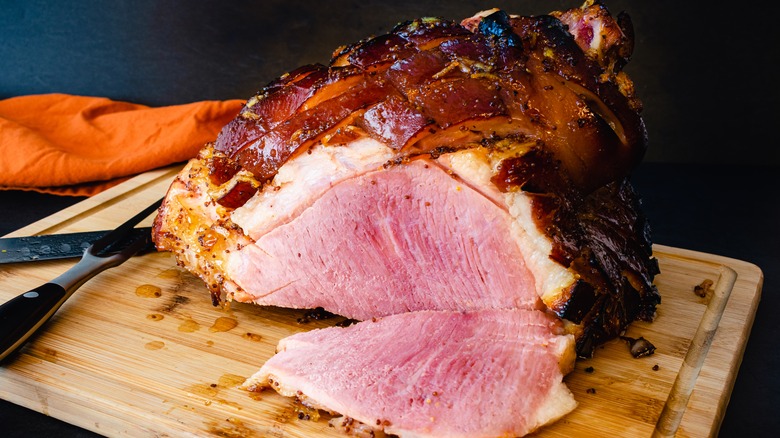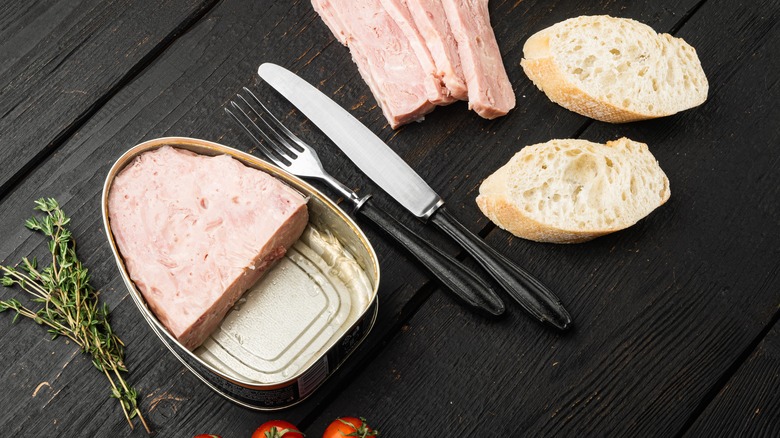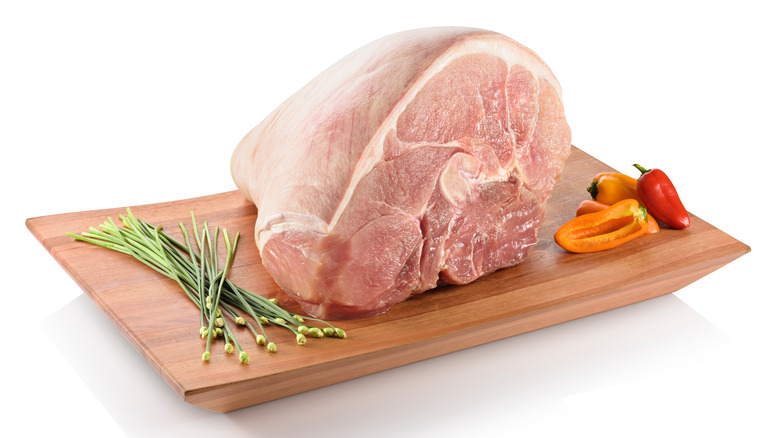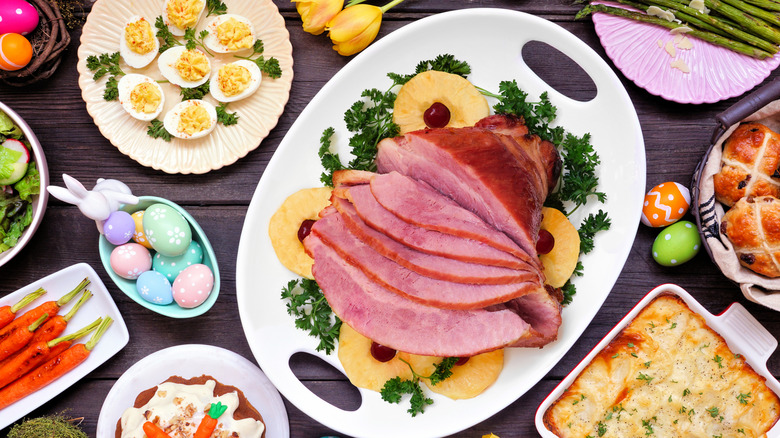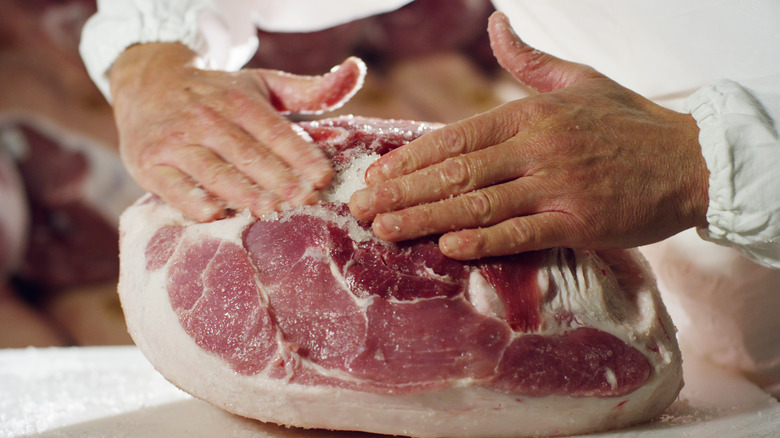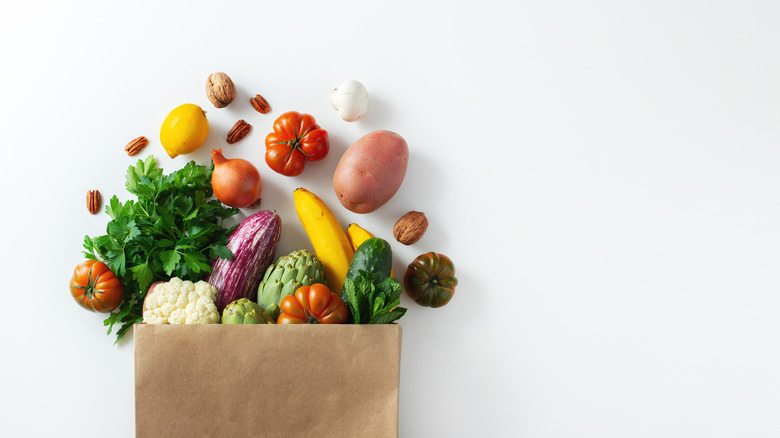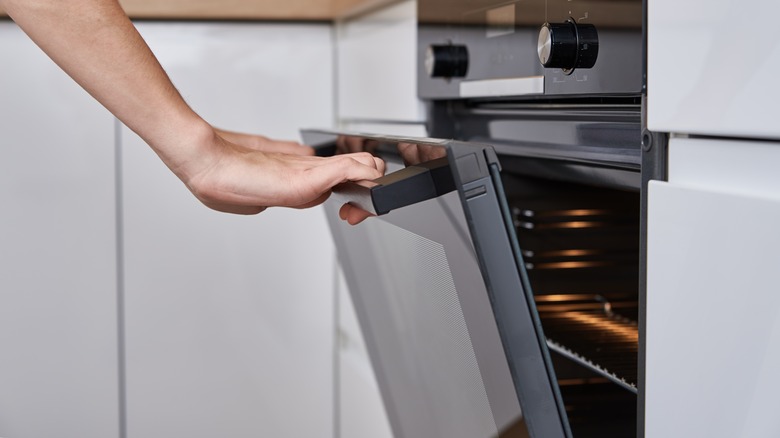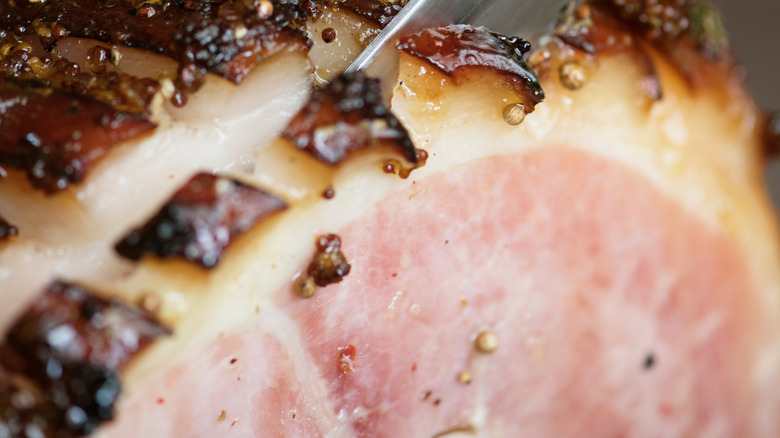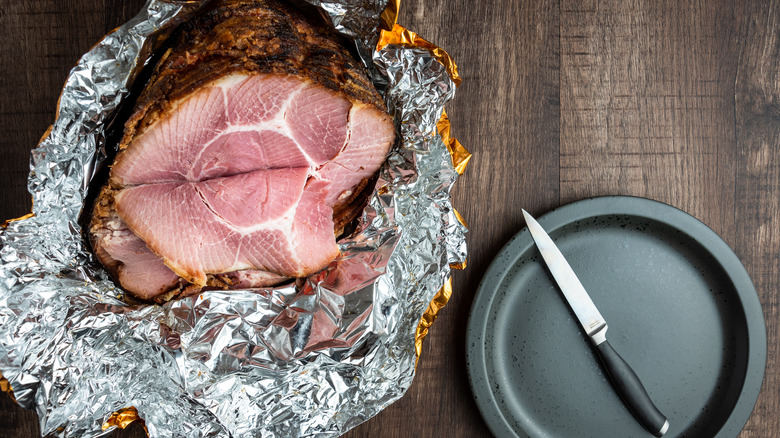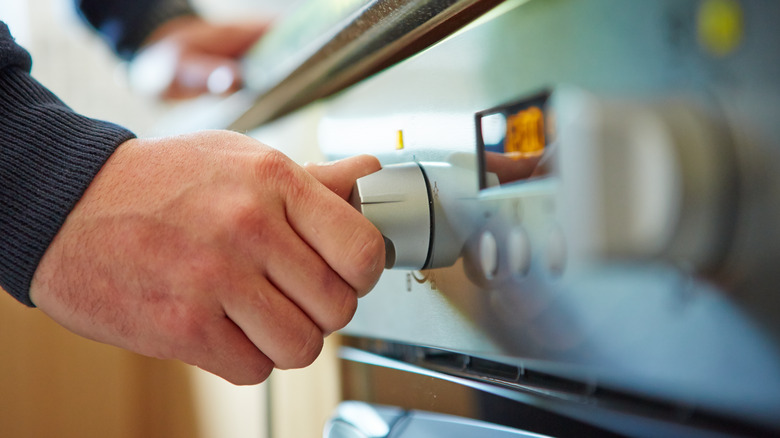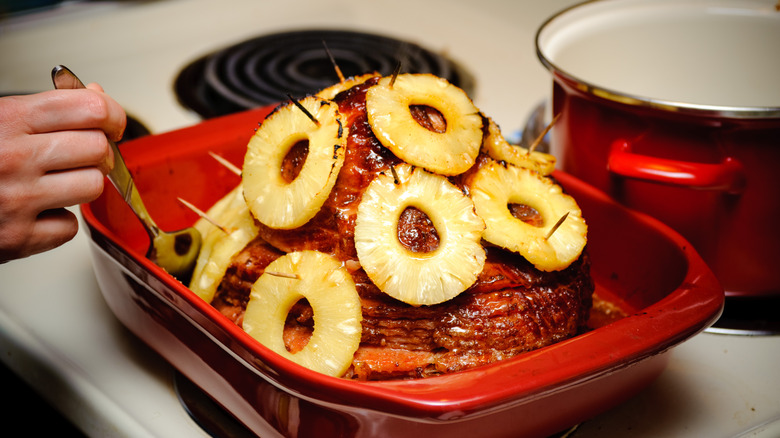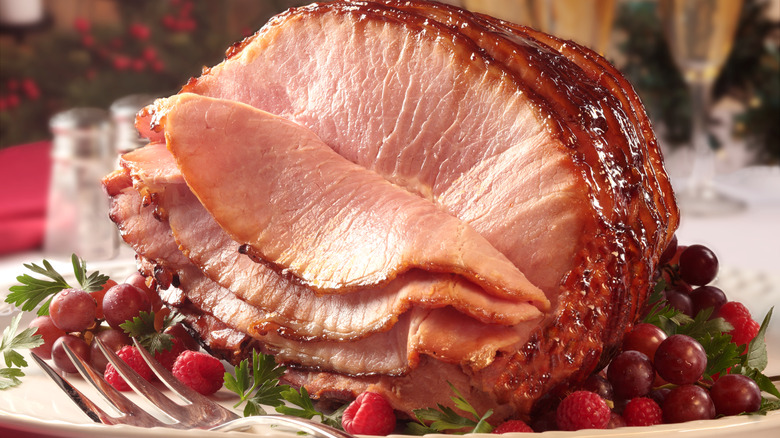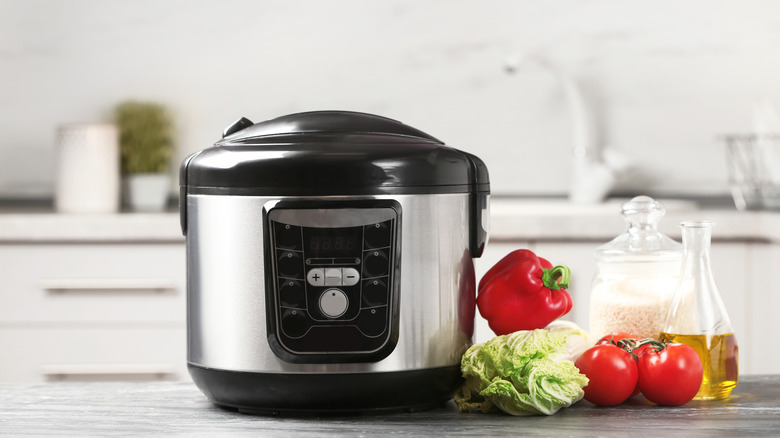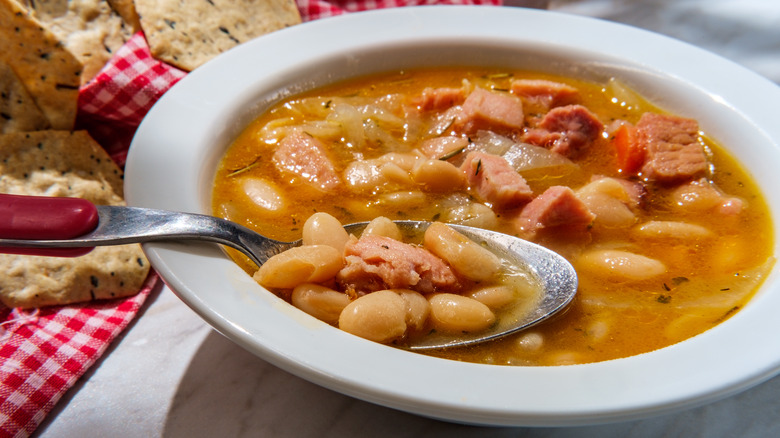14 Tips You Need When Cooking With Ham
A table set with the perfect ham surrounded by eager table guests is like something out of a Norman Rockwell painting. Ham is the perfect dish for the holiday table and has long been a tradition for Easter and Christmas, but it's also perfect as a weeknight meal. It's tender and salty, goes well with plenty of sides, and the sheer number of dishes you can make with the leftovers is reason enough to make a large ham.
So, what's the secret to cooking the perfect ham? There are several things you can do to get the most out of your ham and make sure it's moist and delicious. Follow along as we discuss tips you need when cooking with ham, from how to choose the best one to what to do with the leftovers. The next time you're charged with making holiday dinner, you'll be prepared and ready to impress.
Choose the right ham
Ham is one of the best cuts of pork to roast; however, there are different variations, so it's helpful to understand each type before selecting and cooking one. Choosing the right ham for the job will end in a delicious meal and, hopefully, some leftovers for another dinner.
You'll often hear the words "city ham" and "country ham" when talking about the different types. Farm Flavor explains that a city ham is cured in water and salt, along with preservatives and other flavors. Country ham is simply dry-cured with salt, giving the ham a rich, intense flavor. Both city and country hams will be a shank or the butt portion. The shank has that classic look you expect to see in a ham, while the butt has more meat. There are also spiral-cut hams and canned hams. Spirals are precut, which is convenient, and canned hams are a ham portion that's canned and vacuum sealed.
If ham is cured or smoked, which most are, it's actually pre-cooked for you, per Michigan State University. You're basically just warming it up. Most hams are priced per pound, and a canned ham will be the least expensive.
Understanding ham water content
Some companies inject their hams with water to increase their weight and sell the ham for a higher price. You might think you're getting a good deal because of the weight, but if it's mostly water, you'll get less flavor.
It's important to understand what water content labels mean. If ham is labeled simply "ham," then it's all ham, per Farm Flavor. When water weight (or added water) is 7% to 8% then the ham can be labeled "ham with natural juices." If a label reads "ham, water added," you can expect up to 10% of the weight to be water, and "ham and water product" means water may make up over 10% of the weight of the ham. Canned hams tend to have the most water added to them.
It may seem concerning to have water added to your meat; however, it's harmless. It's just helpful to be aware so you know exactly what you're getting.
Do you need a bone-in ham?
Soup lovers are gasping ... of course you want the bone-in ham, they'll say. How else do magical things like split pea and ham soup happen? For a good soup, yes, you need the bone. After the ham is served and any leftover meat is taken off the bone, adding the ham bone to your soups provides a wonderful flavor that's hard to replace. Besides soup, the ham itself carries more flavor when the bone remains. However, if you don't like carving around a bone or homemade soup isn't on your horizon, you may prefer a ham without a bone. The only benefit of the boneless ham is that it's easy to slice up. There's no getting around it — if you want the best flavor, you should think twice about buying boneless ham.
If it's the carving you find intimidating, don't worry. It's not as hard as it looks. FN Sharp explains that to carve a shank ham, lay the ham so the bone is horizontal to a cutting board and hold it still with a chef's fork. Slice the ham in half, lengthwise above the bone, from the open end to the end of the shank, so you then have two halves. You can then easily slice the top half on the board, then repeat with the other half.
How much ham will you need?
It's the age-old question when making a ham as the main dish ... how much do you need? We've all been there, wondering if we'll have to forgo our own portion of meat at dinner to make sure there's enough for everyone, or just the opposite — worried there will be more leftovers than we know what to do with. According to Roseville Meats, for any meat, you should plan on 1 pound per person if the meat is bone-in, and half a pound if there's no bone. You can cut both of those numbers in half for the children's portion.
Using those calculations, if you're expecting 10 adults for dinner, you'll need a 10-pound ham if it's a bone-in or a 5-pound if it's boneless. However, if you want leftovers (and ham is excellent for leftovers) you should get a couple of extra pounds. One of the biggest mistakes everyone makes when cooking ham is forgetting that there may not be enough left for their favorite recipes the next day if they don't tack on those additional pounds.
You don't have to marinate a ham
Marinades are fabulous and always seem to make the meat taste better. Thankfully, your juicy, salted ham doesn't need a marinade. You can certainly use one if you prefer, but it isn't necessary in order to make your ham taste delicious.
Most baked ham recipes only call for a simple glaze because the ham itself is usually salted or cured for flavor and there's enough fat on ham to keep it moist. A strong marinade might hide the salty goodness of the ham. Spiral hams in particular, such as a honey ham, will not fare well with a marinade since they are already glazed and sliced. Still, if you want to try a marinade and aren't set on the traditional salty ham taste alone, you can give it a go.
One of the most classic and popular ways to marinate a ham is with soda. Yes, marinating with soda is a thing, and it works well with ham since the sweetness complements the meat's saltiness. Other common ingredients in a ham marinade are brown sugar and pineapple juice.
Add some fruits and vegetables
Ham has a ton of salty goodness, and it knows how to share the love. Cooking produce on and alongside your ham creates decadent fruits and veggies for some succulent sides. Carrots, potatoes, apples, and pineapple, the all-time ham favorite, are excellent choices. Check out our glazed pineapple ham recipe, which includes pineapple rings and classic maraschino cherries. Can you get more nostalgic than ham with pineapple rings and a bright red cherry center?
Another favorite with ham is potatoes. Roast them right alongside the ham as it cooks on low. You'll get soft, flavorful potatoes that need little seasoning after hanging out for a couple of hours with the ham juices. You can do the same thing with carrots, zucchini, green beans, apples, garlic, or oranges. Use fruits and veggies to add flavor to the ham or enjoy them as a side dish with your meal.
Always preheat the oven before putting in the ham
The ham is all prepped and you're ready to get cooking ... but the oven is cold. It's essential to preheat the oven before sticking your ham in there. According to Houston Methodist, because an unheated oven may be in the danger zone of 40 to 140 degrees, it's best to heat the oven up to a safe temperature before cooking any meat. Between those two temperatures, microbes can grow on raw food which makes it unsafe to eat. It only takes about 10 minutes on average for an oven to heat up anyway, so it's worth the wait to avoid food poisoning.
Plus, cooking your ham at the right temperature for the entire time will ensure a thoroughly heated ham. And don't even think about defrosting it in the oven — setting ham (or any meat) to defrost in a preheating oven is a big mistake that can ruin your ham and make everyone sick. Defrost your ham in the refrigerator and then put it in the oven once the temperature reaches at least 250 degrees.
Score the top of the ham
Scoring is another important step that shouldn't be overlooked. When you see the picture-perfect ham in a magazine, it usually has flawless diagonal lines on top. Those diagonal lines are called scoring. Scoring allows all the yummy flavors of the glaze, juices, or spices you've used on the ham to trickle deep down into the meat as it cooks. If you've taken the extra step to create a beautiful glaze for your ham, it's a shame to only allow the flavors of it to sit just at the top. With a scored ham, the glaze adds just a touch of extra flavor and sweetness to every bite.
When scoring, cut into the ham about 1/3 of an inch deep and continue to do so all across the width of the ham, then repeat it lengthwise, making the rows about 1 inch apart. When the ham is done, scoring makes it easier to slice the ham as well.
Cover the ham in foil
To trap moisture and give your ham the perfect steam bath, cover it in aluminum foil while it cooks. You should never bake a ham uncovered because you'll risk a dry hunk of meat. The foil keeps all the juices trapped and steams the ham for wonderfully tender results.
Always use foil to cover your ham, never plastic wrap, or you'll have a ham glazed in plastic as it melts. Foil is designed for the oven. Use one or two big pieces of foil, depending on how large the ham is, and gently cover the top, sealing up the foil around the edges of the baking dish. You can also cover just the ham and its sides if you don't want to cover the edges of the dish.
It's okay to lift up the foil now and then to baste the ham or check on the internal temperature. Just place it back when you're done. After it's heated thoroughly, remove the foil and enjoy your steamed, juicy ham.
Cook the ham low and slow
If you're in a hurry, save the ham dinner for another night. The only way to cook a perfect ham every time is low and slow. Cooking any meat at a low temperature for a longer period of time yields a moist result full of flavor, per Lone Star Grillz. Cooking at a high temperature, quickly, risks a dry ham that won't be as tasty.
Ham, whether pre-cooked or not, doesn't need to reach a crazy high temperature to be eaten, which makes low and slow an even better option. The ideal temperature for perfectly cooked pork is around 145 degrees. Most meats require a higher internal temperature than that, but pork seems to reach peak perfection in the 140s. Heat your oven up anywhere from 250 to 325 degrees and, after preparing the ham and covering it in foil, place it in the oven and set your timer according to the weight. Cook time depends on the type of ham, but plan on about 20 minutes per pound for a half ham with the bone in, per Recipe Tips.
Baste your ham as it cooks
Basting is like a warm bath for any meat you're cooking. It is the best way to continually add moisture and flavor to your ham. Basting ensures every area of the ham is getting its fair share of liquid and flavor. VeryMeaty explains that basting your ham prevents the drippings, glaze, and any spices you've added for flavor from being concentrated in one area. Share the wealth by basting a few times throughout the cooking process.
Basting adds plenty of flavor, but it's not a complicated process. It requires the chef to take the ham out of the oven about every 20 minutes, lift the foil, and use your favorite basting tool, such as a brush or baster, to paint the ham with its own juices. Be sure to keep the oven closed while the ham sits out so it doesn't lose heat. Replace the foil and put the ham back in to continue cooking. Continue the basting process until the ham is finished.
Your ham needs a glaze
Remember that Norman Rockwell painting we mentioned earlier? Yeah, there was a glazed ham in the picture. It's an iconic all-American scene and for the best-flavored ham, a glaze is the way to go. Glazes are a sticky coating and often sweet, which is the perfect combination with your salty ham. A glaze often contains delectable treats like brown sugar and bourbon, honey and cinnamon, or Coca-Cola and pineapple juice, creating an impressive ham that guests can't wait to sink their teeth into.
The secret to a good glaze is of course in the ingredients, but also in the timing. If you glaze too early, you'll have a burnt glaze and a sticky mess to clean up. If you've ever pulled dish duty after a holiday meal and had to scrub the roasting pan full of burnt glaze residue, you know how awful it can be. The best time to glaze your ham is when the ham reaches an internal temperature of about 120 degrees. This way the glaze has time to soak in but won't get burnt during those last minutes of cooking.
Try the slow cooker
Now that you know how to make the perfect ham in the oven, let's change things up. For a simpler alternative, break out the slow cooker for the most tender ham possible.
Since a ham does best low and slow, the slow cooker is an obvious answer for a fall-apart, juicy, tender ham. However, you'll need to change things up a bit. One of the mistakes everyone makes when using a slow cooker is not being patient and lifting the lid to sneak a peek. Although you need to baste ham when it's in the oven, do not lift the slow cooker lid to baste your ham. The key to slow cooking is letting all that fabulous steam naturally baste whatever is cooking. It's nearly impossible to end up with anything burnt or dry in a slow cooker because of the way it steams the food.
You can still glaze your ham before putting it in a crockpot, but just understand that you won't see a pretty shiny glaze when it's done. The glaze will turn into liquid and the ham will bathe in the glaze flavor while in the crockpot, which will give you a delicious result. Expect to cook your ham in the slow cooker on low for anywhere from four to eight hours depending on its size, per AllRecipes.
Using your ham leftovers
A big ham right out of the oven is an impressive meal, but perhaps the best part of that meaty main dish is being able to use it for leftovers. Ham is one of the best leftovers because it works for so many different recipes. Store your leftover ham in the refrigerator for up to five days, according to the USDA. After that it gets risky and you'll have to throw away anything that's left. You can also freeze ham and take it out to use in recipes as needed.
Not sure what to do with all your leftover goodness? Try our ham and cheese strata recipe. You probably have everything on hand, such as ham, cheese, and bread, and it's perfect for feeding your guests who slept over after the holiday meal, especially since you can make it the night before. Other leftover ham favorites are split pea and ham soup or croque monsieur. You can even fry up some leftover ham in a skillet with butter for a quick lunch or dinner, or use leftover ham in your morning scrambled eggs.
